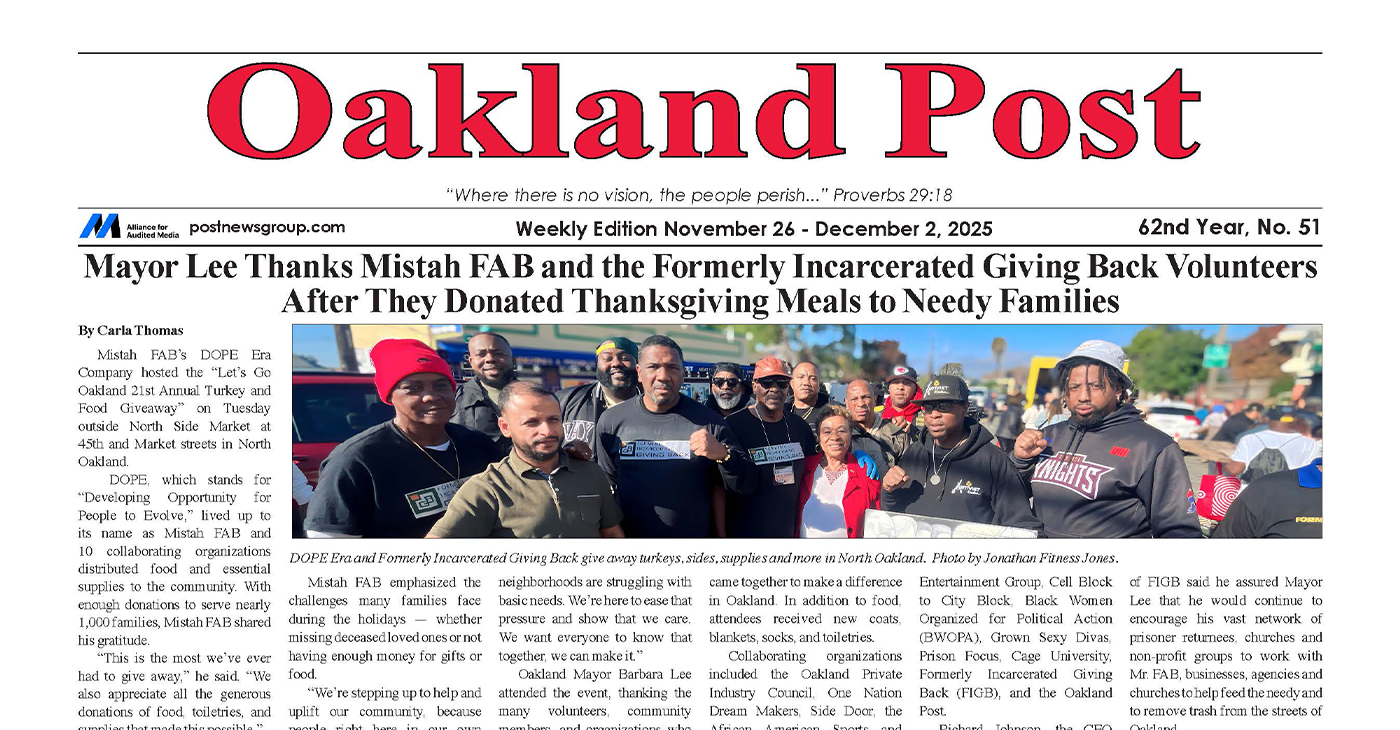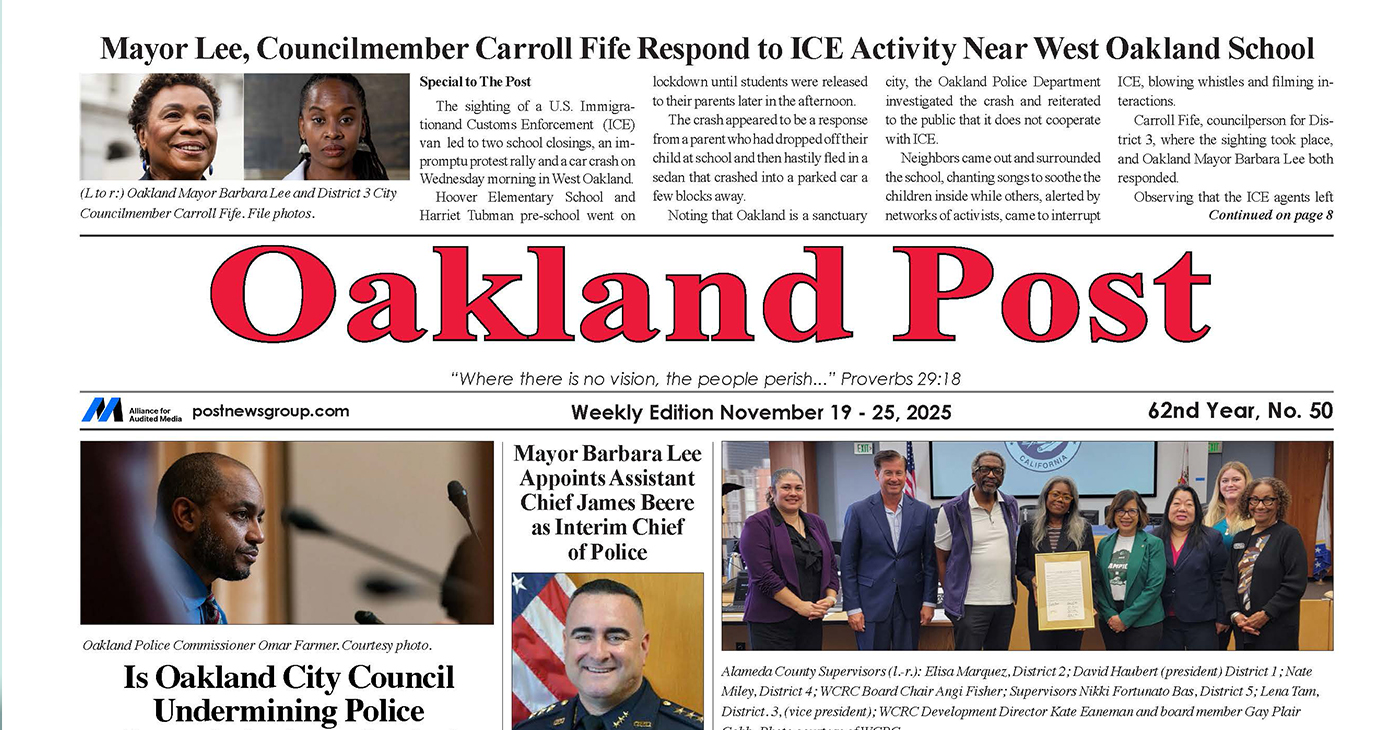Bay Area
Council President Pro Tempore Sheng Thao Introduces Immediate Police Hiring Plan to Address OPD Vacancies, Crime Surge, 911 Response Time
“Being a city leader means breaking through the discourse and finding solutions that are effective and holistic,” said Thao. “While important violence prevention programs like Ceasefire and Town Nights continue to focus on the important community-building that is necessary, it is important that the city improve its 911 response times and ensure nobody is waiting hours for help. Equally, it is important that OPD is supported and staffed at the levels that the Council has already authorized and funded.”

By Council Press Office
Calling Oakland’s efforts to fill its 60 vacant police officers’ positions, “an unacceptable failure,” City Council President Pro Tempore Sheng Thao introduced on Wednesday a new hiring incentive program for the Oakland Police Department (OPD) that will focus on immediately filling officer vacancies.
The program will provide significant cash incentives for experienced police officers and Oakland residents to join OPD. This will improve OPD’s 911 response time, provide the ability to increase the numbers of visible patrol officers, and allow for the expansion of the Ceasefire program. (Ceasefire is a data-driven violence-reduction strategy coordinating law enforcement, social services, and the community, according to the City of Oakland web site.)
Thao’s legislation calls for partnership with an outside hiring agency to conduct a nationwide search for “strongly qualified and experienced lateral police officers,” who are officers that have already gone through police training and are currently serving their respective police departments.
“No one is coming to save us; we’re going to have to save ourselves. That means being aggressive, creative, and disruptive as we look to do things differently at City Hall, because the results are in and what we are doing isn’t working.
“I am introducing a plan to help the City Administration speed up recruitment as well as help save the city dollars and time when filling key vacancies,” explained Thao, “My plan will make Oakland more competitive in its work to hire seasoned, quality officers from across the nation.” This legislation is supported by a broad community coalition from Oakland.
This effort, in combination with Thao’s work in September to secure additional police training academies and provide the overtime OPD is using for walking beats in business corridors during the holidays, reaffirms her commitment to ensuring business corridors are safe, that small businesses can thrive in Oakland and that residents can be assured that crimes will be investigated and police more visible.
Additionally, Thao’s proposal will not take away any of the historical investments Thao and five other councilmembers approved for violence prevention programs.
“Being a city leader means breaking through the discourse and finding solutions that are effective and holistic,” said Thao. “While important violence prevention programs like Ceasefire and Town Nights continue to focus on the important community-building that is necessary, it is important that the city improve its 911 response times and ensure nobody is waiting hours for help. Equally, it is important that OPD is supported and staffed at the levels that the Council has already authorized and funded.”
Daniel Swafford, executive director of the Laurel Business Association and Montclair Business Improvement District said, “I want to thank Councilmember Sheng Thao for her work prioritizing small businesses, our neighborhood commercial districts, and the public safety and health of our communities. Councilmember Thao has brought real, tangible resources to small businesses and their neighborhoods and this legislation is another example of her ability to listen to concerns and provide solutions. I hope the rest of the City Council will vote for this resolution and that the City Administration will push implementation forward.”
The City Council passed a budget in June and the Administration, which reports to the mayor, is responsible to implement it. Currently, the city has hired and deployed fewer officers than the 737 approved by the City Council in June. Thao’s plan to rapidly fill the vacancies will help ensure the public is provided with the resources that have been approved and funded.
Alameda County
Seth Curry Makes Impressive Debut with the Golden State Warriors
Seth looked comfortable in his new uniform, seamlessly fitting into the Warriors’ offensive and defensive system. He finished the night with an impressive 14 points, becoming one of the team’s top scorers for the game. Seth’s points came in a variety of ways – floaters, spot-up three-pointers, mid-range jumpers, and a handful of aggressive drives that kept the Oklahoma City Thunder defense on its heels.

By Y’Anad Burrell
Tuesday night was anything but ordinary for fans in San Francisco as Seth Curry made his highly anticipated debut as a new member of the Golden State Warriors. Seth didn’t disappoint, delivering a performance that not only showcased his scoring ability but also demonstrated his added value to the team.
At 35, the 12-year NBA veteran on Monday signed a contract to play with the Warriors for the rest of the season.
Seth looked comfortable in his new uniform, seamlessly fitting into the Warriors’ offensive and defensive system. He finished the night with an impressive 14 points, becoming one of the team’s top scorers for the game. Seth’s points came in a variety of ways – floaters, spot-up three-pointers, mid-range jumpers, and a handful of aggressive drives that kept the Oklahoma City Thunder defense on its heels.
One of the most memorable moments of the evening came before Seth even scored his first points. As he checked into the game, the Chase Center erupted into applause, with fans rising to their feet to give the newest Warrior a standing ovation.
The crowd’s reaction was a testament not only to Seth’s reputation as a sharpshooter but also to the excitement he brings to the Warriors. It was clear that fans quickly embraced Seth as one of their own, eager to see what he could bring to the team’s championship aspirations.
Warriors’ superstar Steph Curry – Seth’s brother – did not play due to an injury. One could only imagine what it would be like if the Curry brothers were on the court together. Magic in the making.
Seth’s debut proved to be a turning point for the Warriors. Not only did he contribute on the scoreboard, but he also brought a sense of confidence and composure to the floor.
While their loss last night, OKC 124 – GSW 112, Seth’s impact was a game-changer and there’s more yet to come. Beyond statistics, it was clear that Seth’s presence elevated the team’s performance, giving the Warriors a new force as they look to make a deep playoff run.
Activism
Oakland Post: Week of November 26 – December 2, 2025
The printed Weekly Edition of the Oakland Post: Week of November 26 – December 2, 2025

To enlarge your view of this issue, use the slider, magnifying glass icon or full page icon in the lower right corner of the browser window.
Activism
Oakland Post: Week of November 19 – 25, 2025
The printed Weekly Edition of the Oakland Post: Week of November 19 – 25, 2025

To enlarge your view of this issue, use the slider, magnifying glass icon or full page icon in the lower right corner of the browser window.
-

 Activism3 weeks ago
Activism3 weeks agoOakland Post: Week of November 12 – 18, 2025
-

 Activism4 weeks ago
Activism4 weeks agoOakland Post: Week of November 5 – 11, 2025
-

 Activism2 weeks ago
Activism2 weeks agoIN MEMORIAM: William ‘Bill’ Patterson, 94
-

 Activism3 weeks ago
Activism3 weeks agoHow Charles R. Drew University Navigated More Than $20 Million in Fed Cuts – Still Prioritizing Students and Community Health
-

 Bay Area3 weeks ago
Bay Area3 weeks agoNo Justice in the Justice System
-

 #NNPA BlackPress3 weeks ago
#NNPA BlackPress3 weeks agoThe Perfumed Hand of Hypocrisy: Trump Hosted Former Terror Suspect While America Condemns a Muslim Mayor
-

 #NNPA BlackPress2 weeks ago
#NNPA BlackPress2 weeks agoTrump’s Death Threat Rhetoric Sends Nation into Crisis
-

 #NNPA BlackPress3 weeks ago
#NNPA BlackPress3 weeks agoProtecting Pedophiles: The GOP’s Warped Crusade Against Its Own Lies



















































